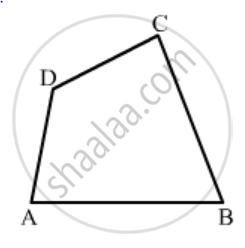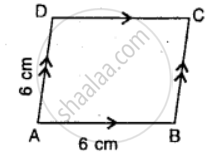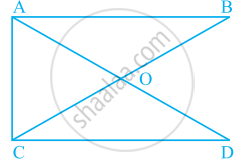Advertisements
Advertisements
प्रश्न
Two adjacent angles of a parallelogram are 70° and 110° respectively. Find the other two angles of it.
उत्तर
Given two adjacent angles of a parallelogram are 70° and 110° respectively.

Since, we know that opposite angles of a parallelogram are equal
∴∠C = ∠A = 70° and ∠D = ∠B = 110°
APPEARS IN
संबंधित प्रश्न
In a quadrilateral, define of the following Vertices .
In a quadrilateral, define of the following Angles .
In a quadrilateral, define of the following Diagonals .
Complete of the following, so as to make a true statement:
A quadrilateral has ....... sides.
Complete of the following, so as to make a true statement:
A quadrilateral has .... diagonals.
Complete of the following, so as to make a true statement:
The sum of the angles of a quiadrilateral is .... right angles.
In Fig. 16.19, ABCD is a quadrilateral.
Name a pair of adjacent angles.

The three angles of a quadrilateral are respectively equal to 110°, 50° and 40°. Find its fourth angle.
Two angles of a quadrilateral are 89° and 113°. If the other two angles are equal; find the equal angles.
In quadrilateral ABCD, side AB is parallel to side DC. If ∠A : ∠D = 1 : 2 and ∠C : ∠B = 4 : 5
(i) Calculate each angle of the quadrilateral.
(ii) Assign a special name to quadrilateral ABCD
Two diagonals of an isosceles trapezium are x cm and (3x – 8) cm. Find the value of x.
One diagonal of a rectangle is 18 cm. What is the length of its other diagonal?
The diagonals of a rhombus are 6 .cm and 8 cm. State the angle at which these diagonals intersect.
Write, giving reason, the name of the figure drawn alongside. Under what condition will this figure be a square.

The angles of a hexagon are (2x + 5)°, (3x - 5)°, (x + 40)°, (2x + 20)°, (2x + 25)° and (2x + 35)°. Find the value of x.
ABCDE is a pentagon in which AB is parallel to DC and ∠A : ∠E : ∠D = 1 : 2 : 3. Find angle A.
ABCD is a quadrilateral in which AB || DC and AD = BC. Prove that ∠A = ∠B and ∠C = ∠D.
Measures of the two angles between hour and minute hands of a clock at 9 O’ clock are ______.
The number of straight angles in figure is ______.
The number of right angles in a straight angle is ______ and that in a complete angle is ______.
